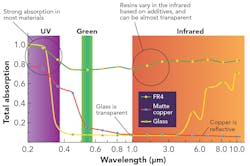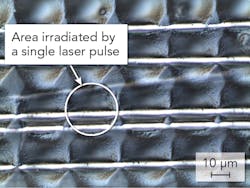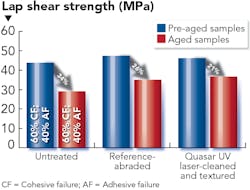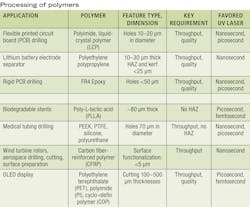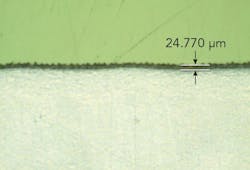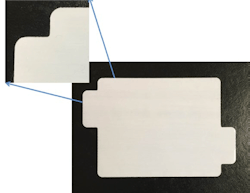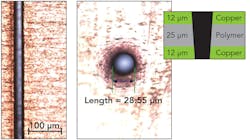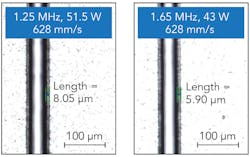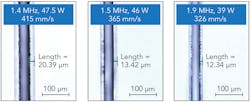High-power UV lasers for precision micromachining
Technological innovation is the hallmark of industrialized society. Manufacturing a physical product for a customer has always meant shaping, altering, and joining various materials. In the context of the present day, that means making something that is more complex, consumes fewer resources, is less expensive, and has more functionality year after year. Therefore, production methods have had to move from traditional machining to advanced machining that is orders of magnitude more precise, being performed on a vastly greater array of materials, at smaller dimensions, and in enormous quantities.
Industries such as transportation, energy, and consumer electronics require ever-increasing functionality at a lower cost. Medical devices benefit from increased miniaturization, but must also meet stringent biocompatibility constraints. The products for these markets require continual improvement on reduction of size and cost, while at the same time enhancing capability.
Industrial lasers have in large part enabled this achievement, especially in markets with acute sensitivity to scale or constraints. In the realm of lasers used for laser micromachining, this often means a migration from the traditional longer wavelengths to those in the ultraviolet (UV) regime. UV lasers have the capability to focus to tighter spot sizes, with shallow absorption depth in most materials. As a result, UV lasers can perform more precise material removal at smaller dimensions and on a wider range of materials.
In this article, we discuss application results using UV pulsed lasers for precision micromachining of various materials, including carbon fiber-reinforced polymers (CFRPs) for automotive and aerospace, polymers for medical devices and clean energy, and multilayered materials for consumer electronics. We find that UV pulsed lasers can deliver both the machining quality and high throughput required in many of these applications.
Challenges of industrial precision micromachining
The first challenge for laser micromachining is removing only the desired material, usually through localized heating. At the same time, the process must minimize damage, generally characterized as heat-affected zone (HAZ), of any of the remaining material.
The second is delivering near-perfect beam quality laser irradiation precisely to the target region. Shorter wavelengths and shorter pulse widths are critical to achieving higher-quality results.
The third challenge for industrial laser micromachining is achieving very high machining throughput. Increased average higher output power can translate into higher ablation rates, but with certain limitations. Laser fluence (defined as energy density [J/cm2]) outside an optimal zone results in decreased material removal efficiency—excess fluence is partly deposited as heat into the material, causing a reduction in throughput and quality, while insufficient fluence results in reduced ablation rates. Thus, along with high average output powers, high repetition rates with sufficiently high pulse energies are necessary to optimally increase throughput, while maintaining machining quality. This is particularly true for ultrashort pulses—the intense peak powers require very high repetition rates to deliver optimal fluence and stay within the desired cold ablation zone. Utilizing very high repetition rates may also require faster scanners and motion control. Spatial beamsplitting and shaping can also be utilized to maintain optimal fluence without increasing repetition rates, but generally results in additional system complexity.
The fourth challenge is managing cost for laser micromachining. The cost increase from the laser process for each manufactured part includes amortization of the upfront laser cost, cost of operation, process yield, and cost of any lost productivity from downtime. Therefore, a critical component to consider is laser reliability, especially in a 24/7 industrial environment. Laser reliability can significantly impact the total cost of ownership.
Advantages of high-power UV lasers
UV lasers have some inherent advantages over their longer wavelength counterparts for precision micromachining (FIGURE 1). Shorter wavelengths and shorter pulse widths are critical to achieving higher quality results. The wavelength dependence of optical propagation means that the power of a short wavelength beam can be focused to a smaller spot size and a beam can maintain its minimum diameter for a greater distance (known as the depth of field). This allows a drilled hole to have less taper or less sensitivity to target location than a longer wavelength beam focused to the same size. Most materials absorb UV strongly and thus the beam’s energy is absorbed within a shallow layer, assisting in material ejection from the surface.
A typical industrial UV laser provides the optical power in pulses of a certain temporal duration, with each pulse interacting strongly near the material’s surface, hence causing material to be removed with each pulse. While each pulse might remove only a small amount of material, applying these pulses at a high pulse repetition rate (PRF) enables the rapid fabrication of precisely controlled features. The smaller attainable spot sizes allow for smaller kerfs (cutting widths), better quality in terms of smaller areas of redeposited material, and less overall heat deposited into the workpiece. Therefore, the detrimental thermal effects affecting the properties of the surrounding material (HAZ) are minimized. As for pulse widths, ultrashort pulses in the picosecond regime yield intense peak powers that result in nonlinear absorption at the sample for instantaneous material vaporization, very minimal heat deposition into the material and negligible HAZ. This is commonly referred to as a “cold ablation” process.
High-power UV lasers can increase process yield and throughput. This yield improvement is due to their higher quality processing. The significant throughput increase is the result of better processing efficiency and higher average power, resulting in lower overall costs for laser machining.
Application: Carbon fiber-reinforced polymers
Increased fuel efficiency and reduced carbon emissions in transportation industries will be critical for growth, enabling more efficient aircraft, electrification of vehicles, autonomous vehicles, ride hailing/sharing services and rental fleet services. These key components will be the foundation for next-generation mobility platforms, such as 5G, which are poised for high growth over the coming years.
The need for lighter weight and stronger materials in the fabrication of various aircraft and automobile parts is driving the use of carbon fiber reinforced polymer (CFRP). CFRP is a lightweight, strong, durable material with good corrosion and vibration resistance. As a result, CFRP is a good candidate to replace many metal parts currently used in aircraft and motor vehicles. An optimally designed CRFP part can be up to 70% lighter than steel and 30% lighter than aluminum, while providing equal or better strength and corrosion performance.
The attributes that make CFRP a unique and useful material also make it difficult to machine with high quality. Conventional mechanical and waterjet cutting techniques are costly, due to high tool wear and operating costs. Also, fiber fracture and delamination of material during machining is very common and results in high yield loss. The use of lasers for machining CFRP provides the advantages of a non-contact process that is readily integrated into automated manufacturing systems. Unlike conventional processes that vary with tool wear, laser processing results in highly uniform machining quality and removes the potential environmental hazards of cooling fluids and particulates from the process. The key challenge for laser machining of CRFP is to machine it with both high throughput and with minimal HAZ formation in the material.
Thin CFRP cutting with a Spectra-Physics Quasar high-power UV hybrid fiber laser is shown in FIGURE 2. The area irradiated by a single laser pulse is indicated. The resin is ablated without fiber damage, demonstrating that material selectivity can be achieved with UV.1Processing of polymers
Polymers are essential constituents in items as diverse as circuit boards, electronic component packages, lithium batteries, carbon-fiber turbine blades, and stents for coronary arteries and as such, need to be processed precisely at high speeds. The application requirements usually restrict the polymer type, the machining feature size will tend to select shorter wavelengths for smaller dimensions, and the material properties drive the pulse duration, as well as wavelength. Polymer properties can be manipulated to a certain extent when needed, most readily with additives that can increase absorption at convenient wavelengths, but fundamental characteristics of low melting points or a tendency to burn in air must be accommodated with the clever application of laser energy from the right laser. The TABLE indicates the diversity of materials, feature sizes, and which pulsed UV laser (in terms of optical pulse width) is favorable for achieving the applications’ key objectives.Application: Lithium-ion battery separators
Lithium-ion battery demand is expanding rapidly as electric vehicle adoption grows, which in itself depends in part on reducing the weight and manufacturing costs of the batteries. There are many challenges for cutting the insulating film separating the electrodes in the battery: the polymer film must be thin for efficiency and weight (FIGURE 4), porous to the cell’s electrolytes, and have high-quality edges (FIGURE 5) in order to preserve the reliability of the battery and to avoid electrical shorting between the electrodes.Processing of multilayered materials
Cutting and drilling layered materials means that two or more sets of constraints must be satisfied with one laser. Metal-on-ceramic, oxide-on-metal, or polymer-metal foil stacks present materials with different absorptions and melting points that require precise control of the laser to avoid inadvertent damage as the layers are penetrated.
The high UV absorption of most materials enables finding similar removal processes through the different layers. High-powered UV lasers with the flexibility to rapidly change pulse energies, pulse trains, and/or pulse durations as cutting or drilling progresses allows maintaining high processing speeds and quality.
Application: Flexible PCB cutting and drilling
Flexible PCBs typically consist of one or more layers of polymer about 25 µm thick and one or more layers of copper foil about 12 µm thick. Flexible PCBs exist in virtually all personal electronic items, so there is a constant drive to reduce the size of all the PCB features, as well as lower the cost of manufacture.
Modern pulsed UV lasers can make thousands of precision-drilled holes per second (FIGURE 6), either through the full PCB or to a controlled depth for subsequently making interconnects between the circuit board layers, known as blind vias. Reductions in the “touch time” on individual circuit boards in order to make billions of personal electronic devices at ever lower costs has been enabled by the increasing UV power available at higher operating frequencies.Processing of OLED materials
Manufacturing of flexible organic light-emitting diode (OLED) displays is critical for next-generation consumer mobile electronic devices. OLED displays are comprised of multiple layers of polymer materials, including polyimide, polyethylene terephthalate (PET), and cyclo-olefin polymer (COP). These materials are transparent to infrared and visible wavelengths and are prone to thermal damage, making them difficult to machine with conventional laser sources. Increasingly, UV picosecond lasers are becoming a promising solution for processing such materials. Both the ultrashort pulse width, providing high peak power, and the UV wavelength, resulting in fine resolution, help to create small, high-quality features at high processing rates.
PET is commonly used as a substrate throughout OLED manufacturing and is typically part of a layered stack that needs to be cut. As a result of its high optical transparency, it is also one of the more difficult OLED layers to cut. 75-µm-thick PET film was cut using a Spectra-Physics IceFyre high-power UV picosecond laser. Increasing the PRF with a slight decrease in pulse energy resulted in a decrease in HAZ from ~8 µm to 6 µm. This improvement is achieved with no loss of cutting speed, which remained at 628 mm/s (FIGURE 7).Future directions
Enabled by advances in high-power UV nanosecond and picosecond lasers, high-volume mainstream industrial precision micromachining processes with demanding quality, throughput, and cost requirements will transition to the performance offered by high-power UV industrial lasers. Products ranging from medical devices and automotive to consumer electronics and clean energy will benefit from the machining quality, high throughput, and overall lower cost per part provided by these types of UV lasers.
ACKNOWLEDGEMENT
Spectra-Physics, Quasar, Talon, and IceFyre are registered trademarks of Newport (MKS Instruments).
REFERENCES
1. Collaboration Study: Spectra-Physics & Technical University of Braunschweig (TUB) [2016].
2. Collaboration Study: Spectra-Physics & Osaka University Japan (2016).
About the Author
Jim Bovatsek
Jim Bovatsek is a senior manager of applications engineering at MKS Spectra-Physics industrial applications laboratory in Milpitas, CA. He has focused on laser applications development using nanosecond, picosecond, and femtosecond pulsed lasers since 2000, with various publications and patents having been generated. He holds a Bachelor of Science (Physics) degree from the University of California, Santa Barbara.
Jeff Kaiser
Senior Product Marketing Manager, MKS Spectra-Physics
Jeff Kaiser, now retired, was Senior Product Marketing Manager at MKS Spectra-Physics (Milpitas, CA) from 2002 through 2021.
Lisa Strugala
Senior Product Marketing Manager, MKS Spectra-Physics
Lisa Strugala is a Senior Product Marketing Manager at MKS Spectra-Physics (Milpitas, CA).
